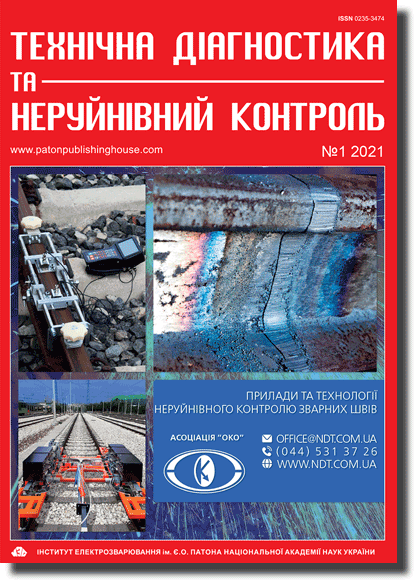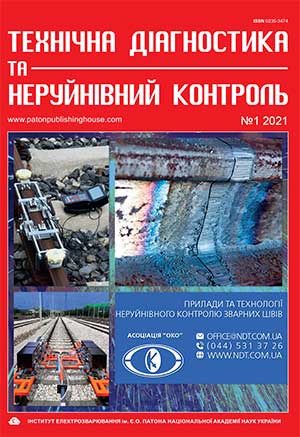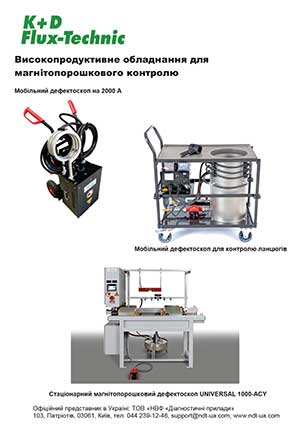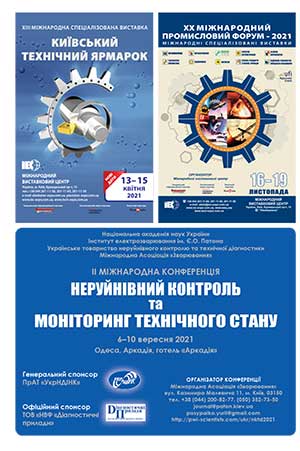| 2021 №01 (05) |
DOI of Article 10.37434/tdnk2021.01.06 |
2021 №01 (01) |
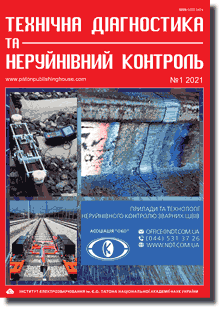
"Tekhnichna Diahnostyka ta Neruinivnyi Kontrol" (Technical Diagnostics and Non-Destructive Testing) #1, 2021, pp. 43-47
Hodographs of interaction of elements of bevel drive in the rolling stand
M.M. Kipin
SE «DIAMECH-UKRAINE», 19 Kirgizska str., 61105, Kharkiv, Ukraine. E-mail:diamech@diamech.com.ua
During development of algorithms for vibration diagnostic systems, special attention is given to studying the main types of rolling equipment, vibration characteristics are determined, and features of the influence of metal rolling technology on the technical condition of the equipment are taken into account. As a result of the conducted examination and analysis of vibraiton parameters of stands of medium section А/С 400/215 and flatting NTLS-1680 rolling mills, a variant of mounting vibration sensors in the vertical direction along the main line of the drive was selected. This variant of accelerometer orientation ensured maximum informativeness of the system during diagnostics of rolling equipment. A design feature of turning stands of medium section mill is the availability of angular gearbox. Here, the sensors mounted on the bearings of the input and output shafts, are located orthogonally relative to each other. Synchronous recording of vibration signals by a measuring module of “Corundum” system allowed revealing certain regularities in the operation of bevel gear in the angular gearbox of the stand. Combining on the software level the temporary signals read from paired sensors resulted in plotting the hodographs of spatial position of reference points of the engaged shafts. The proposed method of visualization allows assessment of the technical condition of the angular gearbox of the stand, in addition to hte available algorithms realized in vibration diagnostics system. Ref. 9, Fig. 9
Keywords: rolling mill, turning stand, angular gearbox, vibration diagnostic system, hodograph, technical condition
Received: 04.12.2020
References
1. (2019) TU 4277-030-54981193-06: Stationary complexes «KORUND» for vibration control of industrial equipment. Specifications, Moscow [in Russian].2. Baglai, A.V., Vorobiov, V.V., Guzeev, A.N., Kipin, M.M. (2020) System of vibration-based diagnostics for rolling production equipment. Chyornye Metally, 2, 62–68 [in Russian].
3. Kalashnikov, S.N., Kalashnikov, A.S. (1983) Gear wheels and their manufacture. Moscow, Mashinostroenie [in Russian].
4. Goldin, A.S. (1999) Vibration of rotary machines. Moscow, Mashinostroenie [in Russian].
5. Shvartsburg, L.E., Filippov, S.V. (1998) Features of selection of position sensor type by the criterion of «generalized desirability ». Moscow, VNIITEMP, Chyornye Metally, 8 (202), 126 [in Russian].
6. Shefer, Kh.Yu. (2001) State of diagnostics of machines in ferrous metallurgy. Chyornye Metally, 6, 28–31 [in Russian].
7. Aigner, Kh., Khelekal, G., Khohraiter, V. et al. (2001) Systems of diagnostics and monitoring in ferrous metallurgy. Ibid., 6, 41–45 [in Russian].
8. Belodedenko, S.V., Ibragimov, M.S. (2017) Selection of intervals between inspections in preventive maintenance of metallurgical equipment. Metal. i Gornorud. Promyshl., 3, 93–102 [in Russian].
9. Verenev, V.V., Bolshakov, V.I., Putnoki, A.Yu. et al. (2011) Dynamic processes in 1680 wide-strip mill stands: Monography. Dnepropetrovsk, IMA-press [in Russian].
Advertising in this issue:
The cost of subscription/purchase order journals or individual articles
| Journal/Currency | Annual Set | 1 issue printed |
1 issue |
one article |
| TPWJ/USD | 384 $ | 32 $ | 26 $ | 13 $ |
| TPWJ/EUR | 348 € | 29 € | 24 € | 12 € |
| TPWJ/UAH | 7200 UAH | 600 UAH | 600 UAH | 280 UAH |
| AS/UAH | 1800 UAH | 300 UAH | 300 UAH | 150 UAH |
| AS/USD | 192 $ | 32 $ | 26 $ | 13 $ |
| AS/EUR | 180 € | 30 € | 25 € | 12 € |
| SEM/UAH | 1200 UAH | 300 UAH | 300 UAH | 150 UAH |
| SEM/USD | 128 $ | 32 $ | 26 $ | 13 $ |
| SEM/EUR | 120 € | 30 € | 25 € | 12 € |
| TDNK/UAH | 1200 UAH | 300 UAH | 300 UAH | 150 UAH |
| TDNK/USD | 128 $ | 32 $ | 26 $ | 13 $ |
| TDNK/EUR | 120 € | 30 € | 25 € | 15 € |
AS = «Automatic Welding» - 6 issues per year;
TPWJ = «PATON WELDING JOURNAL» - 12 issues per year;
SEM = «Electrometallurgy Today» - 4 issues per year;
TDNK = «Technical Diagnostics and Non-Destructive Testing» - 4 issues per year.





